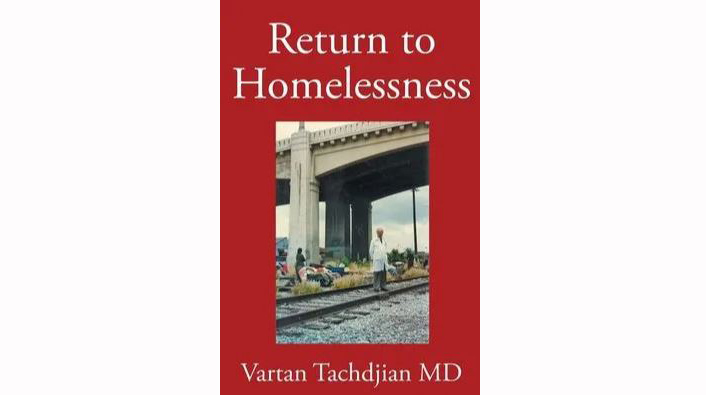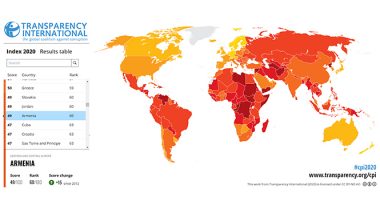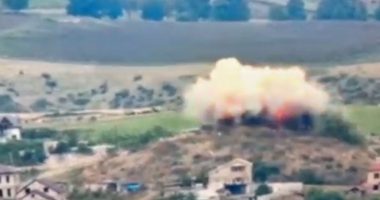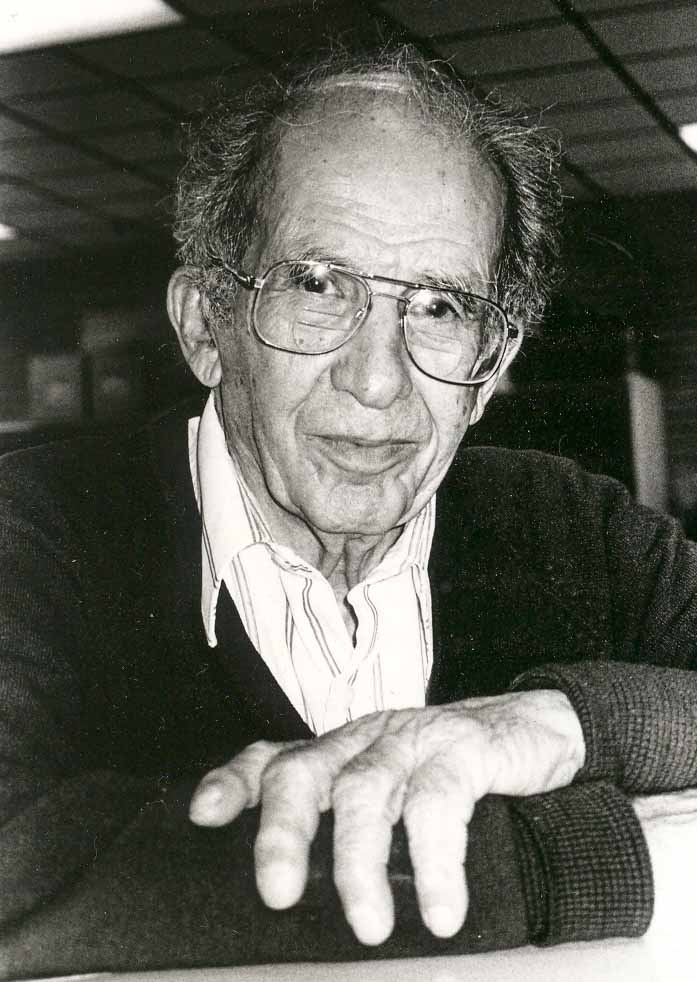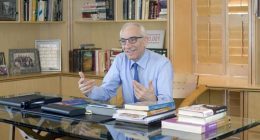Address by Boghos I. Yerevanian M.D. during the book signing ceremony of Dr. Vartan Tashjian’s book “Return to Homelessness” on April 14, 2024 at the AGBU Manoogian-Demirjian School.
I thought I had retired from my public lecturing and presentations after fifty years in academia but when Dr. Tashjian asked me to present his book to this audience, I could not say no, specially after reading his book of which a dedicated copy I will always cherish.
The book is entitled: “Return to Homelessness” and this title already sets the tone. Although essentially an autobiography, it is geared to deliver a poignant message about a most relevant current issue: that of homelessness which is rampant in the wealthiest country and one of the wealthiest cities in the world: Statistics and studies abound; the political discourse on homelessness has reached unprecedented acrimony in this country. I shall not bore you with the details. You see it and read about it everyday. Suffice it to say that as of today some 650000 Americans are homeless and that the city of Los Angeles has an inordinate share of the homeless population. Homelessness does not occur by choice. Rather, it is imposed by severe mental illness, drug and alcohol addiction, physical illness with consequent economic devastation and finally a multitude of societal ills that are too numerous and complex to address here.
But Dr. Tashjian, rather than dealing only with the cold and sometimes heartless scientific data, decided many years ago to address the heart of the problem and to try to understand homelessness from the point of view of the homeless themselves. To achieve that, he complements his years of study of Medicine with a most extraordinary experience: that of becoming homeless, albeit for a short time and by choice, and experience 1st hand what the homeless have to cope with everyday. The 1st few chapters chronicle this extraordinary feat of a physician living under a bridge in downtown LA this time by choice. It is a must read, first for the elegance of the language and descriptive power of the narrative but also to appreciate Dr. Tashjian’s commitment to the cause of homelessness and an understanding of his future career choices chronicled in the book. Sleeping under a bridge in the cold of the night surrounded by rats and the garbage they feed on, facing the obvious physical dangers from addicts or otherwise mentally distraught people is no small feat. This is the real stuff, far from rigorous scientific studies that often veer into irrelevance to the homeless. His approach is hands on, real, clinically relevant and connected to the patients themselves in their own habitat and not in comfortable and safe clinic settings.
Dr. Tashjian’s the personal background leading to this crusade to understand and help the homeless people is fascinating, and the narrative starts in one of the poorest Armenian refugee camps in Lebanon where, post genocide, deprivation was rampant. He grew up in Camp Tiro: the notorious place that we as children were told to avoid, partly to shelter us from seeing so much misery. Reading his crisp yet elegant descriptions of life in that poverty-stricken camp transports you to a feeling of being there: you hear the voices, you smell the garbage and other odors and feel the moisture in those miserable dwellings pounded by rain and storms ,all of which however fail to demoralize this driven yet kind young man determined to succeed and not to use poverty as an excuse to give up.
Where young Vartan grew up, there were no social services, no Medicare and Medi-cal, no organized healthcare, no outreach programs, no government subsidies. Everybody struggled and succeeding was not easy. On top of refugee status, came successive waves of trauma in the form of consequences of two world wars, several civil wars in Lebanon which sometimes tore apart even the Armenian community. Yet today we are honoring a man who succeeded in all domains: career, family, community. It gives hope to others already homeless or about to be.
Apart from his personal triumph over adversity, this book is also an example of the ultimate in physicianhood, true to the Hippocratic oath, with total devotion to one’s profession, especially under conditions of war and adversity.
Dr. Tashjian treated the poor, the destitute and the “unwanted,” rejected by society and alas too often by local and state government entities and even by the medical system itself. Compare the work that Dr. Tashjian did, treating the homeless, organizing outreach as well as clinics and many initiatives to help the homeless, to that of a doctor (alas too many these days) who sees the profession as a business rather than a calling. Dr. Tashjian remains true to his calling despite the severe hardships encountered in his life and this book chronicles the why and how of this commitment to the Hippocratic oath.
Dr. Tashjian’s empathic stance serves as an example to young as well as long practicing physicians. In this era of technological medicine, empathy sometimes is forgotten.
In the course of his mission, he meets Benny, an African American homeless patient who he had treated previously in his clinic. Their meetings and conversations in the streets and in Benny’s shack, reminiscent of his own decades earlier, reveal a side of the homeless individuals that is rarely talked about: that beyond the immediate picture of the disheveled and disorganized homeless there lies a human being, a person with admirable human qualities, often highly cultured , and who deserves compassion, understanding and help. I think every person involved in the management of the enormous homelessness problem in this country, be they politicians, social workers, funding agencies and specially doctors should read this book in order to understand the true nature and complex dimensions of homelessness. Like Vartan Tashjian says and I quote: “But who are the homeless: these men and women we pass on the streets whom we turn our gazes away from. Some of them had ordinary pasts. Many others had extraordinary careers. Yet others were war heroes now forgotten, invisible, unproductive and rejected by society. ….. They are part of humanity”: a sobering thought indeed.
Finally. I want to address the social relevance of this book: homelessness is a multidimensional issue with implications for humanity beyond the ugly physical presentation. It speaks to the very nature of how, as humans, we want to conduct our lives vis-à-vis the poor, the destitute and the disadvantaged, and where moral reasoning prevails.
Many of you may know that the mentally ill in previous centuries were given treatments in the harshest and most inhumane conditions. Patients were literally and physically chained to the walls of the squalid mental institutions like the infamous Bedlam in England or the Salpetriere in France. The mentally ill were treated worse than criminals and less humanely than animals. Until one French psychiatrist set out to change all of that. Philippe Pinel, made history and opened a new era in medicine by physically unchaining the mentally ill from their grotesque shackles and declared:
“Il faut aimer les alienee pour les servir:” that is: you must love the mentally ill in order to help them.” Psychiatry and Medicine were never the same after that event which paved the way for more humane treatments and later on, to concepts of patient’s rights and advocacy movements. Vartan Tashjian carries the tradition of Pinel’s teachings two centuries later. For, most of the homeless, scientific data shows, are still essentially “chained” to their conditions which consist of severe mental and neurological disorders, alcoholism and drug abuse or untenable social and psychological conditions. His work is a continuation of this process of liberating the homeless , the ill from their heavy burdens. That he loves and has compassion for the alienated is evident throughout the book. But is it only love and caring that drives Dr. Tashjian to dedicate decades of his professional life to them? I think his commitment has even deeper roots. How so you may ask?
It is his background: Throughout the book, Dr. Tashjian makes reference to and provides historical data and personal experiences with scores of people important in his life. A central place however he gives to his mother who I gather was the singular person who encouraged him to succeed and confront the difficulties that life presented to him. His reaction to her untimely death was intense and profound but her influence obviously transcended her life, as evidenced by Vartan’s future accomplishments. As Vartan says: “A mayrig is like a single point of radiating light in the universe-at least that is how my mother was to me.”
Beyond his personal tragedy however, the narrative is one of family support, love and empathy as a pathway out of homelessness and in my opinion is the main theme of the book.
The book offers a fresh perspective to American audiences who may be unfamiliar with the Armenian experience and how that shaped a physician’s decision to help the homeless. For while homelessness anywhere is a tragic situation for those on skid row, the pathways to it may be different. A resolve to never let genocide happen again is by and large absent in local culture and paradoxically, that resolve appears to have helped Dr. Tashjian and many like him out of homelessness. One does not come out of the experience of genocide only to give up and end up homeless. I read in Dr. Tashjian;s struggles a certain determination, conscious or unconscious, to fight back, to undo what had been done to his parents and to his nation. It is not possible to read this book without being constantly aware of the background picture of genocide, forced deportation and injustice against which his individual efforts must be seen.
Finally, the message I personally gleamed out of reading this book is that you don’t have to be homeless if you are houseless. That houselessness does not necessarily translate into homelessness because the latter implies not only poverty but in fact abandonment! For homelessness is as much a state of mind, as it is poverty and lack of housing. The homeless are essentially in a state of abandonment: first by abandoning hope themselves, and then by an abandonment by society at large.
The pictures of Dr. Tashjian’s family illustrated throughout the book paint a picture of love, caring and proud resolve, which no doubt are protective factors against homelessness even in the face of abject poverty. And he owes that protection not only to his strength of character, but to his parents, specially his mother but also the whole community at Tiro camp and beyond who really never abandoned him. The implications are clear: the community is crucial in preventing the descent into homelessness. I want to take this opportunity to recognize and pay tribute not only to him but his parents, specially his mother and the whole survivor community in Lebanon that did not give up and later to his wife Madeleine and his two children who stood by him. But Vartan does that himself elegantly by providing names and lots of pictures of these significant people and remembers them with gratitude.
Beyond an autobiography this is a historical narrative of how the community survived and thrived in Lebanon post genocide. A first-hand account of a path out of poverty and homelessness, a powerful message to all willing to hear that coping with homelessness requires more than money and physical dwellings and that it requires medical expertise, an empathic view of the homeless, a love of community and a love of life, all of which Vartan’s life path epitomizes.
Vartzket Gadar sireli Vartan, for a book well written, for a profession well practiced and for a life well lived in the service of others. Congratulations.

